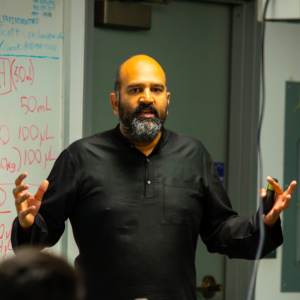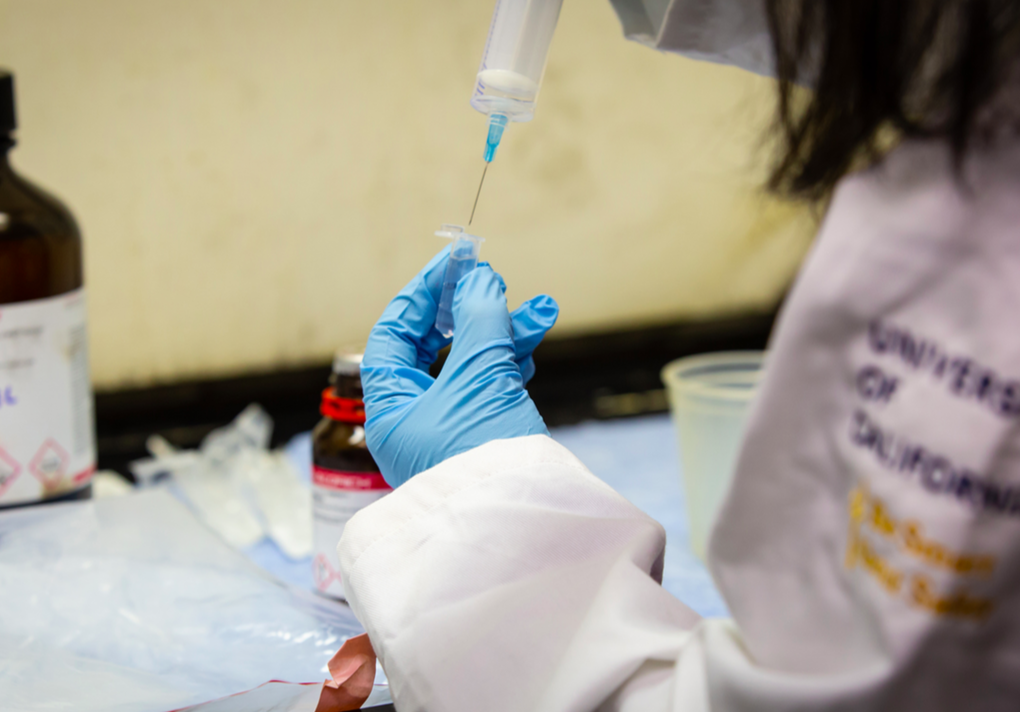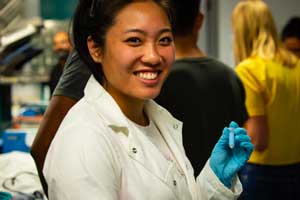Sunil Gandhi Designs Leading-Edge Neuroscience Laboratory Course
By: Michael Gomez
 If you close your eyes, and recall the last time you embarked on something new; a project, a dream, a sport, an activity, a new home, a new gadget -- you will activate your limbic system, filling your brain with feelings of novelty and innovation. You might smile effortlessly, and taste the excitement of possibility. This is what happened to me when I spoke with Dr. Gandhi about his newest passion project and how it changed his goals and aspirations as a scientist and as an educator.
If you close your eyes, and recall the last time you embarked on something new; a project, a dream, a sport, an activity, a new home, a new gadget -- you will activate your limbic system, filling your brain with feelings of novelty and innovation. You might smile effortlessly, and taste the excitement of possibility. This is what happened to me when I spoke with Dr. Gandhi about his newest passion project and how it changed his goals and aspirations as a scientist and as an educator.
We arrived at his office at the same time in the morning. He began describing his work with youthful excitement, while still unpacking his bag. At the forefront of his mind was the new laboratory course he was teaching and in front of him, the camera he was using to document his journey. The cutting-edge content of the new laboratory course combined with the novel teaching philosophy generated the giddiness, which was rapidly becoming infectious. “You see this?” Dr. Gandhi asked, showing me a photo of a mouse brain floating in a clear liquid. “This is a mouse brain.” He advanced to the next photo “You see this?” he asked again, anticipating the puzzled look on my face. The test tube now appeared to be empty. “This is a transparent mouse brain,” he said. I smiled quizzically, feeling like a spectator in a magic show. Dr. Gandhi went on to describe the novel cutting-edge technique known as brain clearing. The method, a highly advanced variant of the technology first pioneered by Stanford’s Karl Deisseroth in 2013, makes brain tissue transparent using hydrogels that maintain tissue structure. Combined with antibody or gene-based labeling, it enables highly detailed pictures of the protein and nucleic acid structure of organs, especially the brain. Dr. Gandhi’s lab has developed some of the most innovative techniques to clear the brain and produce very high-resolution images of its structure using Light Sheet Microscopy.
Building on his lab’s science and methods, and largely driven by his MD/PhD student Ricardo Azevedo, Dr. Gandhi designed a first-of-its-kind, 
interactive laboratory course that immerses students into the excitement of today’s most cutting edge neuroscience.
With mentorship from graduate students, the undergraduates learn brain clearing, programming, imaging, data analysis and, most importantly, how to work together to collect real experimental data. They learn both conceptual and practical skills, and, unlike other lab courses, generate legitimate data that can be used to write grants and papers.
“The mentors play an essential role in this class,” he told me. “With their participation, learning is faster and much more efficient.” Mentored active learning is a win-win. Both mentors and mentees learn and edify each other. Both engage in deeper critical thinking as a result of the process. The mentors learn by teaching and gain valuable experience that is rarely found in other courses. The mentees are open to ideas and are willing to accept help - an experience that can leave a lasting impact that eventually turns the mentee into a mentor. Both duties are challenging, though at times uncertain, but the outcomes are among the most rewarding of human experiences.
Combining advanced neuroscience techniques with interactive mentorship has the potential to have significant positive and lasting impact on the way we train future leaders in neuroscience. This is exactly what Dr. Gandhi is envisioning. He raved about the success of his undergraduate students and the leaps that have taken to overcome the steep learning curves, as well as the thrill among the graduate mentors who are eager to mold these young minds.
I could practically smell the excitement and enthusiasm in the air during the class. “Their faces!” he said. “They are so eager to learn and they’re enjoying it. I am too!”
His focus during the class is on teaching students critical thinking, guiding them through current research, and ensuring that they have a strong conceptual foundation in the basic sciences. He also creates the necessary conditions that enable students to conduct innovative experimentation.
Unsurprisingly, shortly after setting off this “undergraduate nursery”, he noticed how quickly the students adapted and learned to use the high-level techniques they were being taught. He successfully challenged them and they rose to the occasion, suggesting a new model for undergraduate teaching is indeed possible. “Our brains are wired for this type of challenging but exciting learning experience,” he said.
 The success of the students in this course has exceeded all expectations. Data obtained from their work has been used for two grant submissions to the National Institutes of Health. “We want to change the teaching lab culture to plug into what we know already works. That is the scientific way.”
The success of the students in this course has exceeded all expectations. Data obtained from their work has been used for two grant submissions to the National Institutes of Health. “We want to change the teaching lab culture to plug into what we know already works. That is the scientific way.”
How has this experience changed him as a scientist and as an educator? It’s “as if someone has hijacked my mind,” he laughed. It has transformed the way he thinks about education and blurred the lines between research and teaching. He is now preparing a grant proposal to support the expansion of this new course. I asked him for examples of lessons he learned about teaching in this new structure.
“I think what we need more is innovation and entrepreneurship,” he explained. Teaching these principles is quite rare in biological sciences, but is far more prevalent in engineering. Why is this important? An entrepreneurial mindset equips students with a success skill set that is necessary to thrive in today’s job market. Entrepreneurs and innovators think differently and embrace their differences. They do not fear change. Instead, they seek it. They have limitless energy and a strong desire to create and to improve on the status quo.
Can these skills be taught? “Absolutely!” says Dr. Gandhi. Renowned psychologist Robert Sternberg writes that if we were to teach creativity to students, we must first teach them to decide for creativity. There is no better way to teach students to make this decision than by exposing them to the possibilities and excitement of today’s modern neuroscience.
Armed with killer methods and a fiery passion for teaching students to be tomorrow’s innovators, Dr. Gandhi is shaking up the pedagogical model. The results so far have been nothing short of extraordinary!
---
Dr. Gandhi is Associate Professor in the Department of Neurobiology and Behavior at UC Irvine and Associate Director of the UCI Center for the Neurobiology of Learning and Memory. Click here to learn more about Dr. Gandhi's research.

